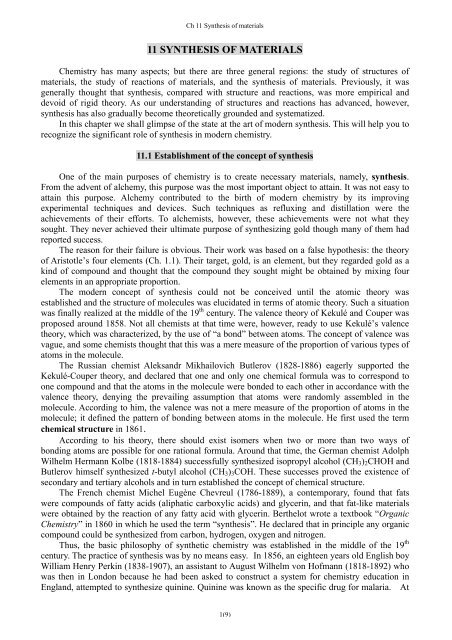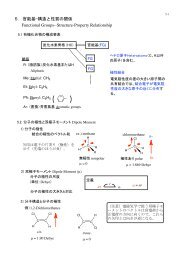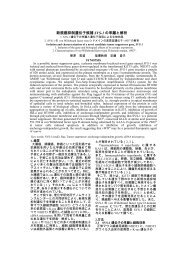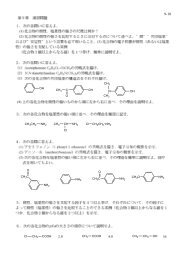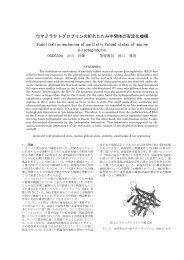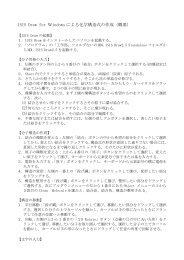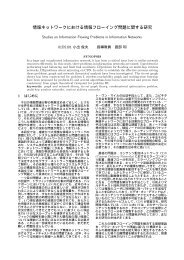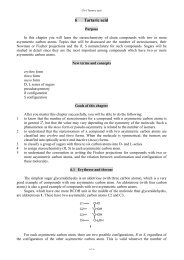Create successful ePaper yourself
Turn your PDF publications into a flip-book with our unique Google optimized e-Paper software.
Ch <strong>11</strong> Synthesis of materials<br />
<strong>11</strong> <strong>SYNTHESIS</strong> <strong>OF</strong> <strong>MATERIALS</strong><br />
Chemistry has many aspects; but there are three general regions: the study of structures of<br />
materials, the study of reactions of materials, and the synthesis of materials. Previously, it was<br />
generally thought that synthesis, compared with structure and reactions, was more empirical and<br />
devoid of rigid theory. As our understanding of structures and reactions has advanced, however,<br />
synthesis has also gradually become theoretically grounded and systematized.<br />
In this chapter we shall glimpse of the state at the art of modern synthesis. This will help you to<br />
recognize the significant role of synthesis in modern chemistry.<br />
<strong>11</strong>.1 Establishment of the concept of synthesis<br />
One of the main purposes of chemistry is to create necessary materials, namely, synthesis.<br />
From the advent of alchemy, this purpose was the most important object to attain. It was not easy to<br />
attain this purpose. Alchemy contributed to the birth of modern chemistry by its improving<br />
experimental techniques and devices. Such techniques as refluxing and distillation were the<br />
achievements of their efforts. To alchemists, however, these achievements were not what they<br />
sought. They never achieved their ultimate purpose of synthesizing gold though many of them had<br />
reported success.<br />
The reason for their failure is obvious. Their work was based on a false hypothesis: the theory<br />
of Aristotle’s four elements (Ch. 1.1). Their target, gold, is an element, but they regarded gold as a<br />
kind of compound and thought that the compound they sought might be obtained by mixing four<br />
elements in an appropriate proportion.<br />
The modern concept of synthesis could not be conceived until the atomic theory was<br />
established and the structure of molecules was elucidated in terms of atomic theory. Such a situation<br />
was finally realized at the middle of the 19 th century. The valence theory of Kekulé and Couper was<br />
proposed around 1858. Not all chemists at that time were, however, ready to use Kekulé’s valence<br />
theory, which was characterized, by the use of “a bond” between atoms. The concept of valence was<br />
vague, and some chemists thought that this was a mere measure of the proportion of various types of<br />
atoms in the molecule.<br />
The Russian chemist Aleksandr Mikhailovich Butlerov (1828-1886) eagerly supported the<br />
Kekulé-Couper theory, and declared that one and only one chemical formula was to correspond to<br />
one compound and that the atoms in the molecule were bonded to each other in accordance with the<br />
valence theory, denying the prevailing assumption that atoms were randomly assembled in the<br />
molecule. According to him, the valence was not a mere measure of the proportion of atoms in the<br />
molecule; it defined the pattern of bonding between atoms in the molecule. He first used the term<br />
chemical structure in 1861.<br />
According to his theory, there should exist isomers when two or more than two ways of<br />
bonding atoms are possible for one rational formula. Around that time, the German chemist Adolph<br />
Wilhelm Hermann Kolbe (1818-1884) successfully synthesized isopropyl alcohol (CH 3 ) 2 CHOH and<br />
Butlerov himself synthesized t-butyl alcohol (CH 3 ) 3 COH. These successes proved the existence of<br />
secondary and tertiary alcohols and in turn established the concept of chemical structure.<br />
The French chemist Michel Eugène Chevreul (1786-1889), a contemporary, found that fats<br />
were compounds of fatty acids (aliphatic carboxylic acids) and glycerin, and that fat-like materials<br />
were obtained by the reaction of any fatty acid with glycerin. Berthelot wrote a textbook “Organic<br />
Chemistry” in 1860 in which he used the term “synthesis”. He declared that in principle any organic<br />
compound could be synthesized from carbon, hydrogen, oxygen and nitrogen.<br />
Thus, the basic philosophy of synthetic chemistry was established in the middle of the 19 th<br />
century. The practice of synthesis was by no means easy. In 1856, an eighteen years old English boy<br />
William Henry Perkin (1838-1907), an assistant to August Wilhelm von Hofmann (1818-1892) who<br />
was then in London because he had been asked to construct a system for chemistry education in<br />
England, attempted to synthesize quinine. Quinine was known as the specific drug for malaria. At<br />
1(9)
Ch <strong>11</strong> Synthesis of materials<br />
that time, no method for synthesizing such a complex compound as quinine from simple organic<br />
compounds was available.<br />
Perkin had an idea that quinine might be obtained by the oxidation of allyltoluidine, which had<br />
a rational formula similar to that of quinine. As a matter of fact that was utterly impossible, and<br />
indeed his attempt to synthesize quinine failed. Instead, however, he obtained a wonderful dye, later<br />
named Mauve or Mauvein, which became the first artificial dye put to practical use. This accidental<br />
success prospered the chemical industry greatly. However, the difficulty of organic synthesis<br />
remained unsolved.<br />
OH<br />
CH 2<br />
CH 2<br />
CH 2<br />
CH 2<br />
CH=CH 2<br />
C<br />
NH 2<br />
CH 3<br />
CH 3 O<br />
CH<br />
CH<br />
N<br />
CH 2<br />
2<br />
O 2<br />
X<br />
O 2<br />
N<br />
CH 2 CH=CH 2<br />
quinine<br />
allyltoluidine<br />
H 3 C<br />
N<br />
H 2 N<br />
N NHC 6 H 4 CH 3 Cl -<br />
Mauve (Mauvein)<br />
Fig. <strong>11</strong>.1 What great luck! By the oxidation of allyltoluidine Perkin obtained,<br />
not the quinine he sought, but the first artificial dye, Mauve.<br />
It was 88 years later in 1944 that the American Chemist Robert Burns Woodward (1917-1979)<br />
was able to synthesize quinine by a systematic approach.<br />
12.2 Synthesis of inorganic industrial materials<br />
Since the structures of inorganic compounds are generally simpler than these of organic<br />
compounds, the synthesis of inorganic compounds had been reasonably advanced from the very<br />
beginning of modern chemistry. Many enterprisers and inventors extensively explored the syntheses<br />
of some useful compounds. In other words, the syntheses of useful inorganic compounds were<br />
actively promoted before their structures or the mechanisms of their reactions were not yet clarified.<br />
Some representative examples are given below.<br />
(a) Sodium carbonate Na 2 CO 3<br />
Throughout the history of industrial chemistry, the supply of sodium carbonate Na 2 CO 3 , soda,<br />
was the most important issue. Soda was an important raw material not only for common daily needs<br />
2(9)
Ch <strong>11</strong> Synthesis of materials<br />
(like soap) but also for more sophisticated industrial products (like glass).<br />
In ancient times soda was obtained from natural sources, and potassium carbonate K 2 CO 3 ,<br />
which also was used for soap, was obtained form wood ash. After the Industrial Revolution, the<br />
demand for soap increased and consequently new synthetic methods were eagerly sought. It was<br />
recognized that soda and salt (NaCl) contained a same element, sodium, and this discovery<br />
prompted attempts to develop a process of producing soda from salt. In the beginning of the 19 th<br />
century, a process was developed in which a mixture of sodium sulfate, the by-product of the<br />
production of hydrogen chloride (to be used for the production of bleaching powder), charcoal and<br />
iron were ignited. The yield was, however, low and was not suitable for large-scale production.<br />
The French inventor Nicolas Leblanc (1742-1806) applied for a contest, held by Académie des<br />
Sciences, for the effective production of soda from salt. The essence of his process was the use of<br />
limestone (calcium carbonate CaCO 3 ) instead of iron.<br />
The outline of Leblanc’s process<br />
Na 2 SO 4 + 2C → Na 2 S + 2CO 2 (<strong>11</strong>.1)<br />
Na 2 S + CaCO 3 → Na 2 CO 3 + CaS (<strong>11</strong>.2)<br />
2NaCl + H 2 SO 4 → Na 2 SO 4 + 2HCl (<strong>11</strong>.3)<br />
Leblanc’s process could provide soda of better quality as compared with the products by<br />
previous methods. However, this process produced a quantity of by-products such as sulfuric acid,<br />
hydrogen chloride, calcium sulfide and hydrogen sulfide. The factories became the target of social<br />
criticism even then. Improvements of Leblanc’s process were highly desirable particularly in view<br />
of the reuse of by-products, which could certainly reduce the cost of production.<br />
One century after the proposal of Leblanc’s process, the Belgian inventor Ernest Solvay (1838-<br />
1922) proposed Solvay’s process (ammonia-soda process), which was much advanced in chemical<br />
and technological aspects. It was already known in early 19 th century that soda could be produced<br />
from salt and ammonium carbonate (NH 4 ) 2 CO 3 . Solvay had experiences on machines and could<br />
design the process of production not only from chemical viewpoint but also from the viewpoint of<br />
chemical engineering. He succeeded to industrialize the process in 1863.<br />
The greatest advantage of Solvay’s process was the use of a tower reactor instead of a tank<br />
reactor. Salt water which dissolved ammonia was poured from the top of the tower and carbon<br />
dioxide was blown into the tower from the bottom so that the product could continuously be<br />
recovered without stopping the reaction. Solvay’s system substantially reduced the cost, and<br />
consequently the new process took the place of Leblanc’s process.<br />
The outline of Solvay’s process<br />
Main reaction<br />
NaCl + NH 3 + CO 2 + H 2 O → NaHCO 3 + NH 4 Cl (<strong>11</strong>.4)<br />
2NaHCO 3 → Na 2 CO 3 + CO 2 + H 2 O (<strong>11</strong>.5)<br />
Circulation of ammonia<br />
2NH 4 Cl + CaO → 2NH 3 + CaCl 2 + H 2 O (<strong>11</strong>.6)<br />
Formation of carbon dioxide CO 2 and calcium oxide CaO<br />
CaCO 3 → CaO+CO 2 (<strong>11</strong>.7)<br />
3(9)
Ch <strong>11</strong> Synthesis of materials<br />
The only by-product of Solvay’s process was calcium chloride, and ammonia and carbon<br />
dioxide were circulated and reused. In production of soda from salt, the crucial point was the<br />
disposal of chlorine. In Leblanc’s process, chlorine was discharged as hydrogen chloride gas but in<br />
Solvay’s process, chlorine was disposed as solid, harmless calcium chloride. By virtue of its<br />
effectiveness and efficiency, Solvay’s process was regarded an example of chemical-industrial<br />
process.<br />
(b) Sulfuric acid<br />
As early as in the latter half of the 16 th century, the German chemist Andreas Libavius (1540-<br />
1616) described a process to obtain sulfuric acid H 2 SO 4 by burning sulfur in wet air.<br />
S + O2 → SO 2 (<strong>11</strong>.8)<br />
2SO 2 +O 2 → 2SO 3 (<strong>11</strong>.9)<br />
Glauber, the first chemical engineer, invented in the middle of the 17 th century, a process to<br />
obtain hydrochloric acid by heating a mixture of salt and sulfuric acid. His hydrochloric acid had<br />
higher concentration as compared with the ones previously obtained.<br />
2NaCl+H 2 SO 4 → Na 2 SO 4 +2HCl (<strong>11</strong>.10)<br />
This reaction is described in high school chemistry textbooks currently in use. Glauber<br />
advertised sodium sulfate as a medicine with marvelous effects and obtained a fortune by selling the<br />
salt.<br />
A more practical process was introduced in which sulfur was heated with saltpeter (potassium<br />
nitrate KNO 3 ). At first the burning was conducted in a large glass jar which contained some water.<br />
The sulfuric acid formed was dissolved in the water. Though the 2 nd step of the process (SO 2 →<br />
SO 3 ) was slow and endothermic, in this process the oxides of nitrogen seemed to act as a catalyst to<br />
promote the reaction.<br />
As the demand for sulfuric acid increased especially because of Leblanc’s process which<br />
required sulfuric acid in quantity, a new device, chamber process using a chamber lined with lead<br />
sheets instead of glass-jar was introduced which made a large scale production possible. A largescale<br />
production of sulfuric acid was necessarily accompanied with a discharge of a quantity of<br />
nitrogen oxides. Such was even then a serious environmental hazard which could not be disregarded.<br />
A few improved processes were introduced using Gay-Lussac and Glover towers. The latter<br />
was widely used since nitrogen oxides could be reused and the yield of nitrate was high with Glover<br />
tower.<br />
The idea of using some catalysts in the production of sulfuric acid, or rather, in the oxidation of<br />
sulfur dioxide was known since ca. 1830. Platinum catalyst was proved effective but very expensive<br />
and hence was not widely used. After half a century when the demand of sulfuric acid increased very<br />
much, the idea of using catalysts revived. After the problem of catalyst poison was solved, the<br />
process using platinum catalyst, i.e., the contact process, became the main process of production of<br />
sulfuric acid. The contact process is used even now though the catalyst used today is not of platinum<br />
but a mixture including vanadium. oxide V 2 O 5 .<br />
(c) Ammonia and nitric acid<br />
Nitrates (salts of nitric acid) had a large demand for the row material of gunpowder from olden<br />
times. The supply was limited, however, and naturally occurring saltpeter (KNO 3 ) was the sole<br />
resource available. In the 19 th century when the scale of wars became enormous, the demand for<br />
nitrates became proportionally large, and the naturally occurring saltpeter could not meet that<br />
demand.<br />
In addition, nitrates were necessary for the row material of artificial fertilizers. It was the later<br />
4(9)
Ch <strong>11</strong> Synthesis of materials<br />
half of the 19 th century when the German chemist Justus von Liebig (1803-1873) proved the<br />
effectiveness and importance of artificial fertilizers. The problem which prevented wider use of<br />
artificial fertilizers was the high price, especially, of nitrogen fertilizers.<br />
At the end of the 19 th century, the English physicist William Crookes (1832-1919) predicted<br />
that the increase of the amount of food produced could not catch up with the increase of population<br />
and the world would run into the catastrophe.<br />
Such circumstances prompted scientists to investigate the artificial fixation of nitrogen, or to<br />
find a process to convert nitrogen which inexhaustibly existed in air into some compounds which<br />
man could use. It was absolutely necessary to carry out the fixation in a large scale. Thus, the<br />
experiment should start in a laboratory scale to end in a factory scale.<br />
The fixation of nitrogen was successfully achieved by he German chemist Fritz Haber (1868-<br />
1934) and the German engineer, employed by BASF, Carl Bosch (1874-1940).The equation for the<br />
Haber-Bosch process is very simple, but technically there are several difficulties. The process was<br />
elaborated so that this exothermic and equilibrium reaction would proceed to the right side<br />
smoothly.<br />
N 2 + 3H 2 → 2NH 3 + 22.1 kcal (<strong>11</strong>.<strong>11</strong>)<br />
In practice, several modifications were made. For instance, the molar ratio of nitrogen :<br />
hydrogen is not 1 :3, but 1 :3.3. The reaction condition was chosen as 300°C at 500 atm. Hydrogen<br />
was used in excess at high pressure so that the equilibrium would shift to the right. Since the<br />
reaction is exothermic, the reaction should better be carried out at lower temperature in view of Le<br />
Chatelier’s principle. On the other hand, the rate of reaction tends to be very slow at lower<br />
temperature. Hence the temperature is kept rather high (i.e., to the extent that the decomposition of<br />
NH 3 will not take place.) Catalyst made of iron is now extensively used.<br />
The Haber-Bosch process became famous as the first example in which the theory of<br />
equilibrium was applied to the practical production. On one hand, the fixation of nitrogen by the<br />
Haber-Bosch process brought a great benefit to man as for the fertilizers. On the other hand, this also<br />
meant that the row material for gunpowder could be obtained inexhaustibly.<br />
The modern process of production of nitric acid HNO 3 is the air oxidation of ammonia. In this<br />
process, ammonia is mixed with excess air, and the mixture is heated to high temperature in the<br />
presence of platinum catalyst to be converted to nitrogen oxide NO, which is further oxidized in air<br />
to nitrogen dioxide NO 2 . Nitrogen dioxide is reacted with water to give nitric acid. This method was<br />
developed by Ostwald, who established the chemistry of catalyst, and is called Ostwald’ process.<br />
The process is represented by the following equations.<br />
The outline of Ostwald’s process<br />
4NH 3 + 5O 2 → 4NO + 6H 2 O (<strong>11</strong>.12)<br />
2NO+O 2 → 2NO 2 (<strong>11</strong>.13)<br />
3NO 2 +H 2 O → 2HNO 3 +NO (<strong>11</strong>.14)<br />
<strong>11</strong>.3 Organic Synthesis<br />
Compared with the synthesis of inorganic compounds, that of organic compounds was much<br />
more difficult. The birth of organic chemistry was attributed to the synthesis of urea CO(NH 2 ) 2 (a<br />
typical organic compound) by heating ammonium cyanate (an inorganic compound) by the German<br />
chemist Friedrich Wöhler (1800-1882). Only recently it became possible to design and synthesize<br />
desired compounds.<br />
5(9)
Ch <strong>11</strong> Synthesis of materials<br />
Reactions used in organic synthesis can be classified into two groups;<br />
1. formation of carbon-carbon bonds<br />
2. Conversion of functional groups<br />
Most of the reactions you learned at high school are the conversion of functional groups as<br />
shown below.<br />
H + HNO 3 NO 2 + H 2 O<br />
(<strong>11</strong>.15)<br />
CH 3 COOH + C 2 H 5 OH<br />
CH 3 COOH + H 2 O<br />
(<strong>11</strong>.16)<br />
To organic synthesis the formation of C-C bonds and the conversion of functional groups are<br />
something like two wheels of a vehicle. It is not appropriate to ask which is more important. A<br />
variety of reactions for C-C bond formation have been reported. Based on the driving force of the<br />
reactions, these can roughly be classified into three types; aldolol condensation, the Grignard<br />
reaction and the Diels-Alder reaction. Here the last two will be explained.<br />
(a) The Grignard reaction<br />
The Grignard reaction was discovered by the French chemist Francois Auguste Victor Grignard<br />
(1871-1935) in 1901. The initial stage of the reaction is the preparation of methylmagnesium iodide,<br />
a Grignard reagent, from the reaction between alkyl halide (methyl iodide in the example below) and<br />
magnesium in dry diethyl ether.<br />
CH 3 I + Mg → CH 3 MgI (<strong>11</strong>.17)<br />
methyl iodide methylmagnesium iodide<br />
You must notice that magnesium is directly bonded to carbon. Such compounds as the Grignard<br />
reagents in which C-metal bonds are included are called the organometallic compound. The C-<br />
metal bonds are labile and leave carbanions such as CH 3 - after the cleavage of the bond takes place.<br />
The anions of carbon like CH 3 - tend to attack positively charged carbon atoms.<br />
It is well known that carbon atoms of an aldehyde group or of a keto group bear partial positive<br />
charge due to electronegative carbon atoms. These carbons are attacked by carbanions such as CH 3<br />
-<br />
to give adducts which will give secondary alcohols from aldehydes or tertiary alcohols from ketones,<br />
respectively, after hydrolysis.<br />
C 6 H 5 CHO + CH 3 MgI → C 6 H 5 CH(CH 3 )OMgI (<strong>11</strong>.18)<br />
benzaldehyde<br />
C 6 H 5 CH(CH 3 )OMgI + HCl → C 6 H 5 CH(CH 3 )OH + MgClI (<strong>11</strong>.19)<br />
1-phenylethanol<br />
C 6 H 5 COC 2 H 5 + CH 3 MgI → C 6 H 5 CH(CH 3 )(C 2 H 5 ) OMgI (<strong>11</strong>.20)<br />
propiophenone<br />
C 6 H 5 CH(CH 3 )(C 2 H 5 )OMgI + HCl → C 6 H 5 CH(CH 3 )(C 2 H 5 )OH + MgClI (<strong>11</strong>.21)<br />
2-phenyl-2-butanol<br />
The Grignard reaction is an example of the reactions of organometallic compounds. Since<br />
many kinds of aldehydes and ketones are easily available, a variety of organic compounds can be<br />
6(9)
Ch <strong>11</strong> Synthesis of materials<br />
prepared with the aid of the Grignard reaction.<br />
Sample exercise <strong>11</strong>.1 The Grignard reaction<br />
In the text, a combination of C 6 H 5 COC 2 H 5 and CH 3 MgI was used for synthesizing 2-phenyl-2-<br />
butanol C 6 H 5 CH(CH 3 )(C 2 H 5 )OH. Indicate other combinations that allow to prepare the same<br />
compound.<br />
Answer<br />
Three types of alkyl groups are included in the final product. These alkyl groups may be a part<br />
of any starting material. Thus, in addition to the combination of C 6 H 5 COC 2 H 5 and CH 3 MgI, two<br />
other combinations are acceptable.<br />
(1) acetophenone C 6 H 5 COCH 3 and ethylmagnesium iodide C 2 H 5 MgI<br />
(2) ethylmethylketone CH 3 COC 2 H 5 and phenylmagnesium iodide C 6 H 5 MgI<br />
(b) The Diels-Alder reaction<br />
The driving force of the Grignard reaction is the attraction between two different electric charge<br />
on two carbon atoms. Such reactions are called the ionic reaction or the polar reaction. There are<br />
other types of organic reactions. One is the radical reaction, the driving force of which is the<br />
reactive radical species generated during the reaction. If a phenyl radical is generated, it will attack a<br />
benzene molecule to give biphenyl.<br />
C 6 H 5 • + C 6 H 6 → C 6 H 5 - C 6 H 5 + H• (<strong>11</strong>.22)<br />
phenyl radical biphenyl<br />
Most of organic reactions are classified into either the ionic reaction or the radical reaction. In<br />
the first half of the 20 th century, it gradually turned out, however, there is another group of reactions<br />
which cannot be classified into none of these two. The representative one is the Diels-Alder reaction<br />
discovered in 1928 by two German chemists Otto Paul Hermann Diels (1876-1954) and Kurt Alder<br />
(1902-1958).<br />
In this reaction an electrically neutral butadiene reacts with maleic anhydride which is also<br />
electrically neutral to give a cyclic product.<br />
CH 2<br />
CH<br />
+<br />
CH<br />
CH 2<br />
CH<br />
CH<br />
CO<br />
CO<br />
O<br />
CO<br />
CO<br />
O<br />
(<strong>11</strong>.23)<br />
butadiene maleic anhydride adduct<br />
Interestingly, it turned out that there are many examples of this type of reactions: a diene<br />
(compounds with two double bonds) and an alkene activated by such as carbonyl of cyano groups<br />
smoothly react to afford cyclic products. It must be added that no reaction takes place between two<br />
butadienes or two maleic anhydride.<br />
In 1965, two American chemists, Woodward and Roald Hoffmann (1935-) explained that this<br />
type of reactions are not the ionic nor the radical reactions, but the reactions are the result of the<br />
overlap of molecular orbitals of two reactants. This interpretation allowed to elucidate the<br />
mechanism of various reactions hitherto unknown.<br />
According to them, a favorable interaction will take place when one reactant (e.g., butadiene)<br />
has four π electrons and the other reactant (e.g., maleic anhydride) two π electrons to afford a cyclic<br />
product. It was shown that the highest occupied molecular orbitals (HOMO) and the lowest<br />
unoccupied molecular orbitals (LUMO) govern the course of the reaction. At the same time Kenichi<br />
Fukui (1918-1999) named these orbitals as the frontier orbital.<br />
The significance of the reactions quoted in this chapter will be acknowledged by the fact that<br />
Grignard, Diels, Adler, Woodward, Hoffmann and Fukui are all Nobel Laureates.<br />
7(9)
Ch <strong>11</strong> Synthesis of materials<br />
Coffee break<br />
The climax of organic synthesis<br />
From the beginning of organic chemistry, organic synthesis may be regarded as the core of<br />
organic chemistry. Organic synthesis may be said to have enjoyed its climax around the middle of<br />
the 20 th century when Woodward was most active. Woodward achieved the syntheses of such<br />
compounds as quinine (1944), strychnine (1954), chlorophyll (1960) and cephalosporin (1966).<br />
Meanwhile he received the Nobel Prize in 1965.<br />
Robert Burns Woodward (1017-1979)<br />
The highlight of Woodward’s achievement is the successful synthesis of vitamin B 12 which was<br />
done with a cooperation with the Swiss chemist Albert Eschenmoser (1925-). The two groups were<br />
responsible to synthesize a half of this complex molecule. After the target species were synthesized,<br />
these were combined to afford vitamin B 12 .<br />
(c) Asymmetric synthesis<br />
As you have learned in Ch. 4, many naturally occurring organic compounds, such as amino<br />
acids, sugars and steroids, have the asymmetric carbon atom. Quinine, which was introduced in this<br />
chapter also has asymmetric carbon atoms. The asymmetric carbon atom plays the key role in the<br />
physiological activity of all these compounds. It must be added that in most cases only one of the<br />
enantiomeric pair is useful for man. In this regards, whether man can achieve the asymmetric<br />
synthesis, an art of selectively synthesizing one of the enantiomeric pair, is a crucial issue.<br />
In the successful examples of the asymmetric synthesis, compounds with the asymmetric<br />
carbon atom, such as terpenes, amino acids and sugars, is chosen as one of the reactant. The<br />
asymmetric carbon atom will make a site which might favor the formation of one of the enantiomer.<br />
The selective formation of one isomer might be affected by the steric effect. In certain cases, the rate<br />
of reaction might be different between two stereoisomers. In other cases, the equilibrium between<br />
two product isomers might be shifted to one side. The selective synthesis of necessary isomer will be<br />
the most important and most extensively investigated topic of organic chemistry in the 21 st century.<br />
There is also more difficult approach in which no auxiliary compounds with an asymmetric<br />
carbon atom is used. If this type of asymmetric synthesis is realized, we shall be able to say that<br />
chemistry can now mimic nature!<br />
Exercise<br />
<strong>11</strong>.1 Solvay’s process<br />
Answer the following questions on Solvay’s process<br />
(1) Write the series of equations from the starting materials to sodium carbonate.<br />
8(9)
Ch <strong>11</strong> Synthesis of materials<br />
(2) Give the name(s) of gas(es) which is (are) repeatedly used in this process.<br />
(3) Calculate the weight of sodium carbonate obtained from 1 ton of sodium chloride.<br />
<strong>11</strong>.1 Answer<br />
(1) See the text.<br />
(2) CO 2 , NH 3<br />
(3) 0.906 ton<br />
<strong>11</strong>.2 The Grignard reaction<br />
You are expected to synthesize an alcohol C 3 H 7 C(CH 3 )(C 2 H 5 )OH by means of the Grignard<br />
reaction. Suggest all possible combinations of organic compounds (an aldehyde or a ketone) and<br />
Grignard reagents (obtainable from bromides).<br />
<strong>11</strong>.2Answer<br />
CH 3 COC 2 H 5 and C 3 H 7 MgBr, C 2 H 5 COC 3 H 7 and CH 3 MgBr, CH 3 COC 3 H 7 and C 2 H 5 MgBr<br />
9(9)


